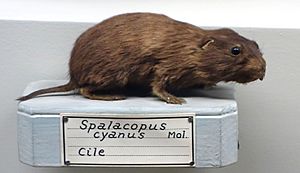Coruro facts for kids
Quick facts for kids Coruro |
|
|---|---|
 |
|
| Conservation status | |
| Scientific classification | |
| Genus: |
Spalacopus
|
| Species: |
cyanus
|
The coruro (Spalacopus cyanus) is a special kind of rodent that lives underground. It's the only species in its group, called Spalacopus. Coruros are found only in central Chile, a country in South America. They live in many different places, from the coast to high up in the mountains. They are known for living in groups and digging tunnels.
Contents
What is a Coruro?
Coruros are strong rodents with big heads and short necks. Their bodies are stocky, meaning they are thick and solid. Their fur is short and dark brown, becoming almost black on their feet. They have small eyes and ears, and their tails are short and smooth.
Built for Underground Life
Coruros are perfectly made for living underground. They have large front teeth, called incisors, that curve forward. They use these teeth to loosen soil and chew through plant roots. Their front legs are very strong for digging, and their back legs are powerful for pushing soil out of their burrows.
They usually weigh between 0.08 and 0.12 kilograms (about 0.18 to 0.26 pounds). Their back teeth have special folds that help them chew their food. Their tails are scaly and don't have much hair. Coruros can be either black or dark brown.
Where Coruros Live
Coruros live along the coast of Chile, from Alicahue to Los Cipreses. They also live high up in the Andes mountains, reaching altitudes of 3,500 meters (about 11,500 feet).
Coruro Habitats
These amazing rodents can be found in many different types of places. They live in grassy areas high in the mountains, and in acacia tree savannas in the central valleys of Chile. You can also find them in sandy areas near the coast and in coastal grasslands.
Coruro Life and Habits
Coruros are social animals that live in colonies. This means many coruros share the same system of underground tunnels. They are also unusual because they are nomadic. When they run out of food in one area, the whole group moves to a new spot and digs a new burrow system.
Colonies and Food
Sometimes, smaller groups of coruros will break off from a larger population. When they move, they often leave behind plant bulbs. This allows new plants to grow, so they can return to that area later for food.
Coruros are quite vocal and make many different sounds. They eat only underground plants like grasses, herbs, roots, and bulbs. A big part of their diet is a plant called Leucocoryne ixioides. They also eat bulbs from plants like Dioscorea longipes, Libertia, Sisyrinchium, or Alophia.
Family Life and Predators
Coruros have a specific breeding season, usually from June to March. A female coruro can have up to six babies at a time. Their pregnancy lasts about 77 days. The babies' eyes open about four days after they are born.
Coruros have natural enemies, such as hawks, owls, and wild cats. Luckily, coruros are not currently an endangered species.
See also
 In Spanish: Cururo o Chululo para niños
In Spanish: Cururo o Chululo para niños


